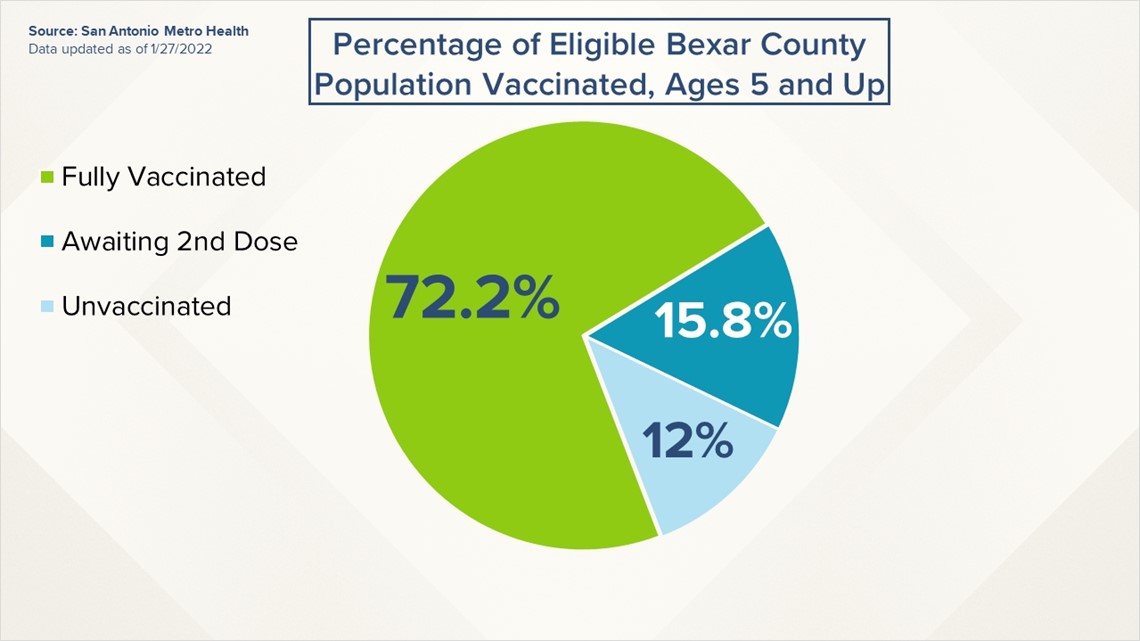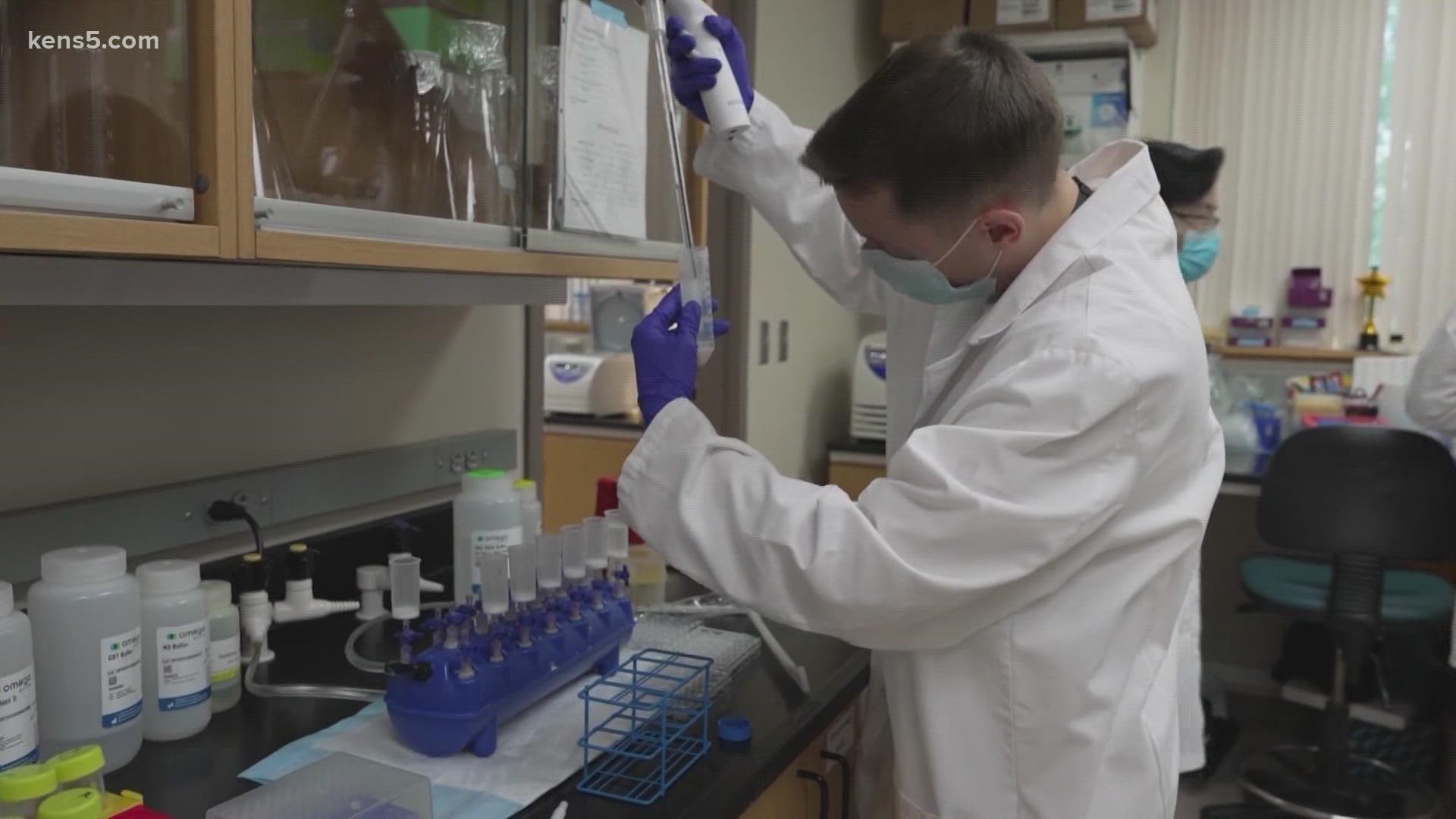SAN ANTONIO — A prolonged pandemic, relaxed restrictions and a highly contagious omicron variant resulted in Bexar County's worst month for new COVID-19 cases in January, with 30% of the area's total coming in the first month of 2022.
That total of nearly 148,000 cases includes 2,983 reported by Metro Health on Monday and 2,672 on Sunday, which are among the lowest tallies of the year thus far. The seven-day case average dropped on Monday to 4,311, compared to 5,534 a week ago.
January, however, wasn't nearly as deadly as it was COVID-contagious. After Metro Health reported two more virus-related deaths on Monday, the San Antonio area's pandemic death toll rose to 5,096, with 2.4% of those reported in January.
Meanwhile, the coronavirus continues to test regional health care systems. On Monday there were 1,196 Bexar County patients hospitalized with COVID-19, which is a jump of 28 from Sunday.
Metro Health says 12% of staffed beds were open to take a new patient on Monday.
More city-operated vaccine pop-up clinics have been announced for this week, while tens of millions of dollars are being allocated by the government to Bexar County health care workers who have been diagnosed by COVID-19.
Virus woes are also wreaking havoc at San Antonio's Toyota plant, where production was slashed roughly in half this month due to the pandemic's economic effects.
And, as Americans continue to receive their at-home testing kits this month, here's how you can best ensure you're self-testing the right way.
How Bexar County is trending




Vaccine Progress in Bexar County
The following numbers are provided by San Antonio Metro Health. A full breakdown can be found here.
- 1.667 million eligible Bexar County residents have received at least one dose of the coronavirus vaccine as of Thursday, Jan. 27, representing 88.9% of the county's population eligible (those over the age of 4) to receive a vaccination.
- 1.367 million eligible Bexar County residents are fully vaccinated as of Thursday, Jan. 27, representing 72.2% of the county's population eligible to receive a vaccination.


The CDC states that "when a high percentage of the community is immune to a disease (through vaccination and/or prior illness)," that community will have reached herd immunity, "making the spread of this disease from person to person unlikely."
The City of San Antonio breaks down the vaccination rates by zip code on Metro Health's Vaccination Statistics page.
Coronavirus in Texas
The total number of coronavirus cases in the state since the pandemic began grew by 26,529 on Monday, according to the Texas Department of State Health Services. That total includes 23,582 new confirmed cases and 2,947 new probable cases. More details can be found on this page.
Monday's figures bring the total number of Texans diagnosed with COVID-19 to more than 6.219 million.
An additional 24 Texans have died from virus complications, meanwhile, raising the statewide death toll to 78,160.
Coronavirus symptoms
The symptoms of coronavirus can be similar to the flu or a bad cold. Symptoms include fever or chills, cough, shortness of breath or difficulty breathing, fatigue, muscle or body aches, headache, new loss of taste or smell sore throat, congestion or runny nose, nausea or vomiting, and diarrhea, according to the Centers for Disease Control.
Most healthy people will have mild symptoms. A study of more than 72,000 patients by the Centers for Disease Control in China showed 80 percent of the cases there were mild.
But infections can cause pneumonia, severe acute respiratory syndrome, kidney failure, and even death, according to the World Health Organization. Older people with underlying health conditions are most at risk.
Experts determined there was consistent evidence these conditions increase a person's risk, regardless of age:
- Chronic kidney disease
- COPD (chronic obstructive pulmonary disease)
- Obesity (BMI of 30 or higher)
- Immunocompromised state (weakened immune system) from solid organ transplant
- Serious heart conditions, such as heart failure, coronary artery disease, or cardiomyopathies
- Sickle cell disease
- Type 2 diabetes
- The CDC believes symptoms may appear anywhere from two to 14 days after being exposed.
Human coronaviruses are usually spread...
- Between people who are in close contact with one another (within about 6 feet).
- Through respiratory droplets produced when an infected person coughs, sneezes or talks. These droplets can land in the mouths or noses of people who are nearby or possibly be inhaled into the lungs.
- Some recent studies have suggested that COVID-19 may be spread by people who are not showing symptoms.
Help stop the spread of coronavirus
- Stay home when you are sick.
- Eat and sleep separately from your family members
- Use different utensils and dishes
- Cover your cough or sneeze with your arm, not your hand.
- If you use a tissue, throw it in the trash.
Find a Testing Location
City officials recommend getting a COVID-19 test if you experience fever or chills, cough, shortness of breath or difficulty breathing, fatigue, muscle or body aches, headache, new loss of taste or smell, sore throat, congestion or runny nose, nausea or vomiting, or diarrhea.
Here's a Testing Sites Locator to help you find the testing location closest to you in San Antonio.
Latest Coronavirus Headlines
- Texas students, frustrated by limited COVID-19 protocols, turn to petition drives and walkouts
- Joe Rogan denies spreading misinformation after artists drop Spotify over his show
- Here are the long-term symptoms of the omicron variant
- Coronavirus Tracker: Bexar County caps deadliest week for COVID-19 deaths since September
- Pfizer starting trials to create a vaccine specific to omicron variant
- 5 Caribbean destinations added to CDC 'avoid travel' list
- How to get the most accurate results from a rapid coronavirus test
- Canadian Prime Minister Justin Trudeau says he has tested positive for COVID-19
- Government steps in to help pay for COVID expenses in Bexar County
- Booster shots needed against omicron, CDC studies show

